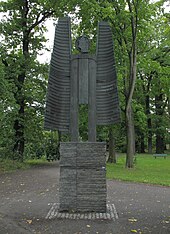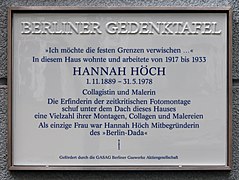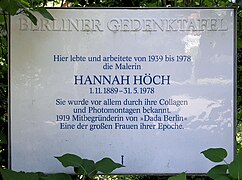Hannah Höch

Hannah Höch , actually Anna Therese Johanne Höch (born November 1, 1889 in Gotha ; † May 31, 1978 in West Berlin ), was a German painter, graphic artist and collage artist of Dadaism .
life and work
Hannah Höch was the daughter of an insurance director, her mother was a hobby painter. She attended the secondary school for girls in Gotha from 1896 to 1904 . When she was 15, she had to drop out of school to take care of her siblings.
In 1912 Höch enrolled at the Berlin School of Applied Arts and thus emancipated herself from her middle-class parents. When the First World War broke out in 1914 , Höch traveled to Cologne to visit a large Werkbund exhibition. In the following year she became a student of Emil Orlik at the educational establishment of the Kunstgewerbemuseum Berlin . There she met Raoul Hausmann , who was already married, in 1915 and entered into a love affair with him that lasted seven years. For a long time, as a woman in art , Höch was seen primarily as a Dadaist at Hausmann's side and not as an independent artist. With him she stylistically developed the photo montage . From 1916 to 1926 she worked for Ullstein Verlag , mostly for magazine publishers. Through Hausmann, she got to know the Dadaist circles in Berlin in 1917. In 1919 she was on stage in a Dada revue with a children's pistol and pot lids.

In 1920 she took part in the First International Dada Fair and from that year onwards she participated in the annual exhibitions of the November Group. In the same year she and Hausmann visited the Dadaists in Prague. In 1922, Höch separated from Hausmann. After the breakup, he called after her that she had never been a "member of the club". Höch later said, quite self-critically: "If I hadn't spent a lot of my time looking after him and encouraging him, I would have achieved more myself."
In 1924 she traveled to Paris for the first time. On the return trip she visited Piet Mondrian and his group De Stijl . The Soviet Union made it possible for Höch to take part in an exhibition in 1924. The German Art Association in Berlin invited her to an exhibition in 1925. In 1926 she met the Dutch writer Til Brugman , with whom she lived and worked in The Hague in 1929 and then in Berlin until 1936. Their joint book bill Minced appeared in 1935 in the Rabenpresse of Victor Otto Stomps . Avant-gardists such as Theo van Doesburg and Kurt Schwitters expressed themselves partially negative about this relationship.
In 1932 Höch got the opportunity to exhibit in the USA. In the time of National Socialism , Höch's work was considered “ degenerate art ” and was prohibited from exhibiting. Until 1938 she earned her living by designing dust jackets for novels that were published by Zeitschriftenverlag AG (ZAG). The publisher of these books was her Dutch friend Anthon Bakels , who also paid for her for a life-saving operation in 1934.
At some point between 1935 and 1937, Höch separated from Brugman. In 1938 she married the sales representative Kurt Heinz Matthies, who was 21 years her junior, and from whom she divorced in 1944; She traveled with him, sometimes for months, all over National Socialist Germany , including in neighboring occupied countries (e.g. Holland ). Stations, experiences, etc. during these car journeys, sometimes with a trailer, were recorded in notes in her diaries and thus documented, among other things, her experience of the November pogroms in 1938 or the German attack on Poland .
Some of Höch's late works, including Am Tränenpfuhl (1956) and Ausmontierte Seelen (1958), "exude the glaring artificiality of car paint, foils or plastic."
In 1965 Hannah Höch was appointed to the Academy of Arts in West Berlin . She was a member of the German Association of Artists .
Hannah Höch died on May 31, 1978 at the age of 88 in Berlin: she was buried in the state's own Heiligensee cemetery . The grave in Dept. 19 UR-6-15 is one of the graves of honor of the State of Berlin.
Honors
The Council of Europe exhibition in 1977 at the Akademie der Künste on “Trends in the 1920s” distinguished Hannah Höch by showing 24 of her works. In the same year, 1977, the city of Berlin (West Berlin) awarded the artist an honorary professorship.
Since 1996, the State of Berlin has awarded the Hannah Höch Prize, endowed with EUR 15,000, for outstanding artistic life's work.
The city of Gotha named a path in the Sundhausen district after the artist. A bookshop on Gotha's main market also bears her name. There is a Hannah Höch community school in Berlin-Reinickendorf.
Berlin memorial plaque , Büsingstrasse 16, in Berlin-Friedenau , residence of Höch 1917–1933
Works (selection)
Works in the Berlin Dada fair 1920
External web link !
- 1919: Cut with the kitchen knife. Dada through the last Weimar beer belly culture epoch in Germany , Neue Nationalgalerie, Berlin. In this almost one square meter large, well-composed hidden object , Höch assembled letters and scraps of words like anti or dada between the depicted machine and body parts from snippets from magazines and newspapers . So the whole thing breaks down into many perspectives.
- 1921: Man and Machine , Nuremberg, Germanisches Nationalmuseum , Gm 1943, oil on canvas, 107 cm × 85 cm
- 1926: From an ethnographic museum , Nuremberg, Germanisches Nationalmuseum, Hz 6899 (loan from the estate), collages.
- 1936: Autumn in the Jungfernheide park in Berlin , oil on canvas, Darmstadt, Hessisches Landesmuseum, foundation from private ownership 2012.
- 1945: Picture book , published posthumously by The Green Box, Berlin 2008, ISBN 978-3-908175-35-3
reception

At the later famous "Dada fair" of 1920, the artist cut with the kitchen knife with the assembly created in 1919 . Dada represented by the last Weimar beer belly culture epoch in Germany . Sixty years later, the art historian Jula Dech subjected this complex panel painting, which later became a kind of icon of Dadaism, to an extensive investigation in which she systematically traced almost all of the individual assembly elements back to the context of their medial origin. With this deconstruction of her, published as a revision in 1993 in the paperback series Kunststück (see literature) published by Klaus Herding , the author set a new methodological standard for access to montage in general and for that of Hannah Höch's Dadaist work in particular.
Entrusted by the artist's heirs with a first inspection of her artistic estate, Jula Dech (together with Ellen Maurer) organized a first congress on her work at the Berlin Academy of Arts on the occasion of Hannah Höch's 100th birthday at the end of 1989 . At this symposium, Höch and DADA specialists from Europe and the USA dealt with the artist's work both analytically and art-historically as well as artistically and practically - comprehensively documented in the volume Dada between-talk to Hannah Höch, published by Dech / Maurer .
Through the Hannah Höch archive in the Berlinische Galerie under Eberhard Roters , research on the artist's entire oeuvre was considerably expanded and deepened by u. a. Hanne Bergius , Ralf Burmeister, Karoline Hille, Alma-Elisa Kittner, Maud Lavin, Maria Makela, Ellen Maurer, Cornelia Thater-Schulz, Cara Schweitzer, Eva Züchner.
Solo exhibitions (selection)
- 2017: Hannah Höch and the collage , picture book museum , Troisdorf
- 2017: Hannah Höch - In Search of Hidden Beauty , Gallery and Publishing House St. Gertrude
- 2016: Hannah Höch - Revolutionary of Art , Kunsthalle Mannheim and Art Museum Mülheim an der Ruhr .
- 2016: Curtain up for Hannah Höch , Kunsthaus Stade
- 2014: Hannah Höch , Whitechapel Gallery , London.
- 2008: Hannah Höch - Every beginning is DADA , Museum Tinguely , Basel.
- 2007: Hannah Höch - Every beginning is DADA , Berlinische Galerie , Berlin.
- 1993: Hannah Höch , Museums of the City of Gotha.
literature
- Hanne Bergius : Dada's laugh. The Berlin Dadaists and their actions , Anabas-Verlag, Giessen 1989, ISBN 978-3-8703-8141-7 .
- Hanne Bergius: assembly and metamechanics. Dada Berlin - Aesthetics of Polarities (with reconstruction of the First International Dada Fair and Dada Chronology), Berlin: Gebr. Mann Verlag 2000, ISBN 978-3786115250 .
- Hanne Bergius: Dada triumphs! Dada Berlin , 1917–1923. Artistry of Polarities. Montages - Metamechanics - Manifestations. Translated by Brigitte Pichon. Vol. V. of the ten editions of Crisis and the Arts. The History of Dada, ed. By Stephen Foster, New Haven, Conn. et al., Thomson / Gale 2003, ISBN 978-0-816173-55-6 .
- G. Jula Dech: Cut with the kitchen knife Dada through the last Weimar beer belly culture epoch in Germany (= form and interest. Volume 3). Lit-Verlag, Münster 1981.
- G. Jula Dech, with Ellen Maurer (ed.): Da-da between speeches on Hannah Höch , documentation of the Höch Congress in 1989 in the Berlin Academy of the Arts, in the series The other view .
- G. Jula Dech: Hannah Höch. Cut with the kitchen knife Dada through the last Weimar beer belly culture epoch in Germany . Fischer Verlag, Frankfurt am Main 1989, ISBN 3-596-23970-2 . Orlanda Frauenverlag, Berlin 1991, ISBN 3-922166-41-5 .
- G. Jula Dech: Seven Views of Hannah Höch , Edition Nautilus, Hamburg 2003, ISBN 3-89401-401-6 .
- Karoline Hille: Hannah Höch: The Twenties: Art.Love.Friendship. edition ebersbach, Berlin / Dortmund 2014, ISBN 978-3-86915-095-6 .
- Inge Herold, Karoline Hille: Hannah Höch. Revolutionary in art. The factory after 1945 . Catalog for the exhibition in Mannheim and Mülheim an der Ruhr. Edition Braus, Berlin 2016, ISBN 978-3-86228-139-8 .
- Thomas Hatry: ZAG Hannah deserves her bread . Bibliography of the novels published by Zeitschriftenverlag AG 1932–1942. Heidelberg, 2015.
- Hannah Höch (= art sheets from Galerie Nierendorf 33), Berlin 1975.
- Hannah Höch , ed. Kamen Pawlow, Museums of the City of Gotha. Verlag der Buchhandlung Ulenspiegel / Bücherstube Hannah Höch, Fulda / Gotha 1993. ISBN 3-9801740-7-7 .
- Hannah Höch, Gunda Luyken: Album . Hatje Cantz Verlag, Ostfildern 2004, ISBN 3-7757-1427-8 (Höch's collection of materials from 1925/26).
- Hannah Höch. Every beginning is DADA! Published by Berlinische Galerie. Hatje-Cantz, Ostfildern 2007.
- Hannah Höch: picture book. with an afterword by Gunda Luyken. The Green Box, Berlin 2008, ISBN 978-3-908175-35-3 .
- Hannah Höch , eds. Dawn Ades, Emily Butler and Daniel F. Herrmann, Whitechapel Gallery, London. Prestel Verlag Munich / London / New York, 2014. ISBN 978-3-7913-5343-2 .
- Curtain up for Hannah Höch , catalog for the exhibition at Kunsthaus Stade , Michael Imhof Verlag, Petersberg 2015, ISBN 978-3-7319-0313-0 .
- Alma-Elisa Kittner: Visual Autobiographies. Collecting as a self-design by Hannah Höch, Sophie Calle and Annette Messager . Transcript, Berlin 2009, ISBN 978-3-89942-872-8 .
- Karoline Künkler: Hannah Höch and Raoul Hausmann. In: Karoline Künkler: From the darkrooms of modernity. Edited by Anne-Kathrin Reulecke and Ulrike Vedder. Böhlau Verlag Cologne / Weimar / Vienna 2012, ISBN 978-3-412-18005-8 , pp. 402–509.
- Wolfgang Maier-Preusker , in: Books and portfolios with graphics of German Expressionism. Exhibition catalog for the Hanseatic city of Wismar. Vienna 2006, ISBN 3-900208-37-9 .
- Harald Neckelmann (Ed.): “The world widened for me”. Hannah Höch's address book . Transit, Berlin 2018, ISBN 978-3-88747-364-8 .
- Natias Neutert : Lady Dada. Essays about the picture (inventor) Hannah Höch. Lilienstaub & Schmidt, Berlin 2019, ISBN 978-3-945003-45-9 .
- Ursula Peters , Andrea Legde: Modern Times. The 20th century collection (= cultural-historical walks in the Germanic National Museum; vol. 3). Nuremberg 2000, in particular pp. 112-120 passim .
- Gesine Sturm, Johannes Bauersachs: The garden of Hannah Höch, I travel to my garden ; with DVD: Peter Carlberg: Diptam, Bauernzingel, Bunter Mohn, the garden of my aunt Hannah Höch . Stapp, Berlin 2007, ISBN 978-3-87776-199-1
- Cara Schweitzer: Unlimited freedom for Hannah Höch. The life of an artist. 1889-1988 . Osburg-Verlag, Berlin 2011, ISBN 978-3-940731-64-7 .
radio play
- With Hannah Höch, Berlin-Heiligensee, August 12, 1977. By Bernd Baader. First broadcast: Bayerischer Rundfunk / radio play and media art August 11, 2017.
- Further into the night. Calendar 1937–1939 . Text collage: Herbert Kapfer , composition and realization: Helga Pogatschar . Production: Bayerischer Rundfunk / radio play and media art 2014.
- The artist Hannah Höch . Hanne Bergius in conversation with Julian Doepp, BR PODCAST. BR2. De, October 31, 2014
Web links
- Literature by and about Hannah Höch in the catalog of the German National Library
- Works by and about Hannah Höch in the German Digital Library
- Friends of Hannah Höch with biography
- Further exhibitions by Hannah Höch , www.kunstaspekte.de
- Virtual Hannah Höch archive
Individual evidence
- ↑ a b Catrin Lorch: Minas Manifest. Exhibitions and books celebrate the Dada women. Finally, because only then does the whole movement become visible. , in: Süddeutsche Zeitung , No. 30, 6./7. February 2016, p. 17.
- ↑ cf. ibid.
- ↑ Hanne Bergius: Unlimited freedom for HH, in: Das Lachen Dadas. The Berlin Dadaists and their actions. Ed .: Anabas-Verlag. Anabas-Verlag, Giessen 1989, ISBN 978-3-87038-141-7 , pp. 130-143 .
- ↑ Deutschlandfunk.de , March 21, 2015: radio play on Saturday
- ↑ kuenstlerbund.de: Ordinary members of the German Association of Artists since it was founded in 1903 / Höch, Hannah ( memento from March 4, 2016 in the Internet Archive ) (accessed on August 26, 2015)
- ↑ Hannah Höch died in Berlin . In: Frankfurter Allgemeine Zeitung of June 2, 1978, p. 23.
- ↑ Project funding and artist funding from the Berlin cultural administration ( Memento from January 15, 2010 in the Internet Archive )
- ↑ Illustration of the painting and explanations , www.hlmd.de, accessed on February 14, 2016.
- ^ Hanne Bergius: Assembly and Metamechanics. Dada Berlin - Aesthetics of Polarities (with reconstruction of the First International Dada Fair and Dada Chronology) . Gebr. Mann Verlag, Berlin 2000, ISBN 978-3-7861-1525-0 .
- ↑ events , troisdorf.de
- ↑ Hannah Höch - In search of hidden beauty , st-gertrude.de
- ^ Announcement on the exhibition ( Memento from June 29, 2016 in the Internet Archive ), Kunsthalle-Mannheim online, accessed on June 29, 2016.
- ↑ Exhibition September 2016 to January 2017 ( Memento from October 22, 2016 in the Internet Archive )
- ^ Announcement from the Kunstmuseum Stade on the exhibition ( Memento from June 29, 2016 in the Internet Archive ), Museen-Stade online, accessed on June 29, 2016
| personal data | |
|---|---|
| SURNAME | High, Hannah |
| ALTERNATIVE NAMES | Höch, Anna Therese Johanne Höch (maiden name) |
| BRIEF DESCRIPTION | German painter, graphic artist and collage artist of Dadaism |
| DATE OF BIRTH | November 1, 1889 |
| PLACE OF BIRTH | Gotha |
| DATE OF DEATH | May 31, 1978 |
| Place of death | West Berlin |





